- Home
- The Winter Garden
- Winter Flowers
Plan to Include Winter Flowers
in Your Garden for
Color and Fragrance
When it comes to plants with winter flowers, there are more choices than you might expect to add life to your winter landscape.
My first choice for flowers for the winter garden is always pansies and violas. These charmers add color and fragrance to your garden in winter and can be used in so many ways--as bedding plants for masses of color, as borders, as accents, to overplant spring bulbs, and in containers. Other annuals for consideration include snapdragons, dianthus, alyssum and ornamental cabbages and flowering kales.
Bulbs such as snowdrops, crocus, and reticulated iris that
bloom in late winter/early spring are a delight, and can be naturalized
in drifts of color that will increase every year. Of course, don't forget amaryllis (HIppeastrum) for indoor holiday color.
Hellebores, certainly, are a must for the winter garden. These tough perennials are beautiful, long-lasting and easy to grow.
There are a surprising lot of winter-blooming shrubs and trees. Though most bloom during periods of warmth and closer to spring, they let us know that winter is almost over, and often have the bonus of delightful fragrance.
Annuals for Winter Flowers
Antirrhinum majus, snapdragons, Zones 7-11. Snapdragons are tender perennials or biennials, usually used as annuals as they prefer cooler temperatures. In the South, they are often planted in the fall and will survive the winter to bloom through the spring, and indeed, often last through the summer. They come in a wide range colors including white, yellow, peach, orange, pink, red and purple, making them versatile additions to the border. And, of course, they delight children with their “snapping” mouths—and hummingbirds love them too!
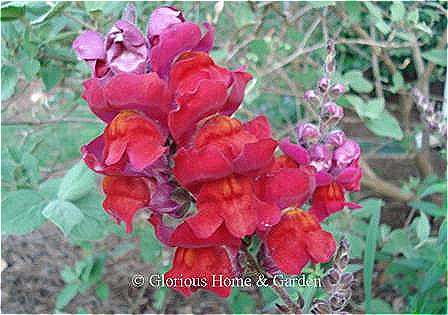 Antirrhinum majus 'Aromas Red Spice'
Antirrhinum majus 'Aromas Red Spice'Brassica oleracea capitata, ornamental cabbage and Brassica oleracea acephala, flowering kale, Zones 2-11. Though ornamental cabbage and flowering kale are in the same genus and species as the vegetables we all know, they are classified as a distinct group and are not generally eaten having a bitter taste. So, they are used purely as decorative elements and add much to the beauty of the fall and winter garden in containers and as bedding annuals. In fact, they require cool temperatures to produce the best colors. In Zone 7 and below they may survive the winter until warmer temperatures cause them to bolt and set seed, at which time they are discarded. Colors range from white to pink, red and purple with some varieties having finely divided leaves (considered flowering kale) and some with broader leaves that resemble roses (considered ornamental cabbage). Combine them in containers with pansies and violas, or in beds with other cool weather annuals like dianthus or snapdragons and include some spring bulbs for a lovely display.
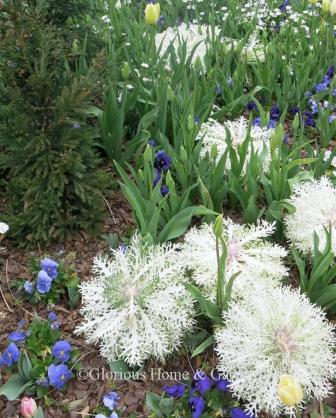 'White Peacock' flowering kale with pansies and tulips
'White Peacock' flowering kale with pansies and tulipsViola cornuta, viola or horned violet, Zones 5-11. Charming and cheerful, violas are a must in the winter and spring garden. Though smaller than their pansy cousins, they are more cold tolerant, and put on a colorful show with their prolific bloom. New varieties of violas have been developed in a wide range of colors, including white, yellow, orange, peach, pink, rose, violet, blue, purple, and near black, in bi-color and tri-color combinations. They are superb for mass planting for drifts of color, to edge a path, in beds, borders, and containers, and make great companions with spring bulbs and cold-tolerant annuals like sweet alyssum, dianthus, English daisies, forget-me-nots, pansies, and wallflowers.
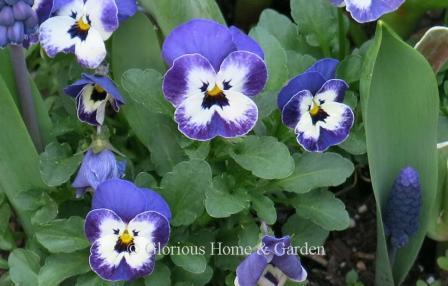 Viola cornuta Sorbet 'Delft Blue'
Viola cornuta Sorbet 'Delft Blue'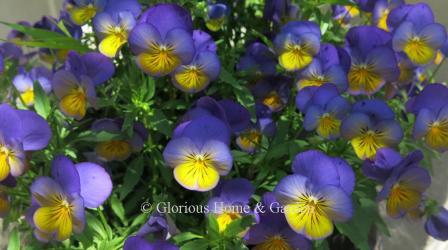 Viola cornuta Sorbet XP 'Morpho'
Viola cornuta Sorbet XP 'Morpho'Viola tricolor, Johnny-jump-up, viola, Zones 3-9. Viola tricolor is one of the species used to develop the pansies and violas we know and love today. Its charming “face” and tricolors of blue, white and yellow have endeared it to gardeners for centuries. Easy to grow, and will self-seed where happy.
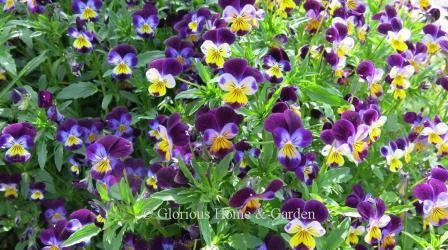
Viola x wittrockiana, pansy, Zones 4-11. Pansies are much loved for their rainbow of beautiful colors, cheerful "faces" and fresh scent. In the milder areas of the country (Zones 7 and above) they are planted in the fall to overwinter and will bloom in the fall, slow down during the coldest part of winter and resume as the days lengthen. They are best treated as annuals because by the end of May they begin to languish in the growing heat and can be replaced with summer annuals. Sometimes they will self-seed and reappear in the fall when the temperatures cool off.
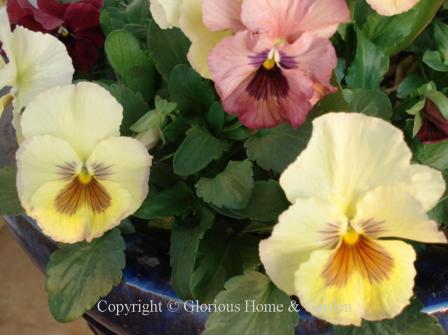 Viola x wittrockiana 'Imperial Antique Shades'
Viola x wittrockiana 'Imperial Antique Shades'Bulbs for Winter Flowers
Crocuses--There are crocuses that bloom in spring and fall, and there are a few that are extra early and bloom in late winter to early spring.
Crocus ancyrensis 'Golden Bunch,' Zones 3-8. An early bloomer, ‘Golden Bunch’ is a cheery sight in late winter or early spring with its burst of golden blooms.
 Crocus ancyrensis 'Golden Bunch'
Crocus ancyrensis 'Golden Bunch'Crocus chrysantha, golden crocus, Zones 4-7. Another early blooming species of
crocus. There are other colors available
besides the yellow of the species—white, cream, blue and purple.
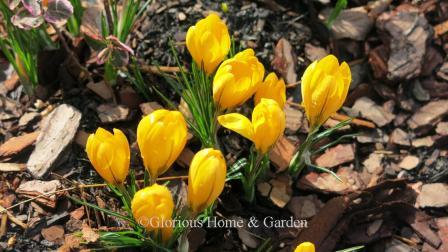 Crocus chrysantha 'Dorothy'
Crocus chrysantha 'Dorothy'Crocus etruscus, Zones 5-8. Pale lilac.
Crocus imperati, Zones 5-9. Striped yellow on the outside, purple on the inside.
Crocus sieberi subsp. sublimis ‘Tricolor' Zones 3-8. An intriguing little purple crocus with a golden throat edged in white, ‘Tricolor’ blooms in late winter to early spring. In my 7b garden, it bloomed in mid-February; however, one day they were in full bloom, the next the rabbits (or deer) had nibbled them to the ground, so they were not able to return the next year. But they were charming, so if I try them again I will plant them in a pot.
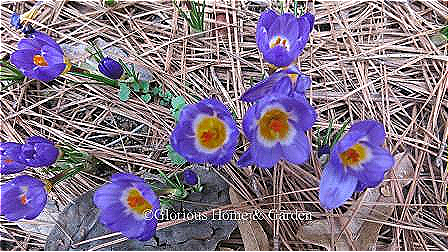 Crocus sieberi subsp. sublimis 'Tricolor'
Crocus sieberi subsp. sublimis 'Tricolor'Crocus tommasinianus, Tommasini's crocus Zones 3-8. Purple. Nicknamed "tommies" these charmers bloom in late winter to early spring and are great to naturalize in large drifts under the still bare trees where they can be left undisturbed to increase in number.
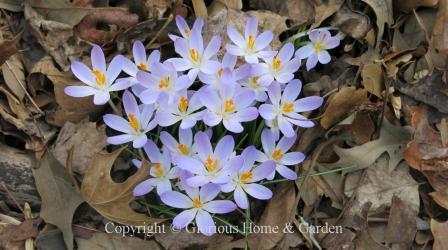 Crocus tommasinianus
Crocus tommasinianusEranthis hyemalis, winter aconites, Zones 4-9. These small bright yellow flowers look like they are wearing green Elizabethan collars and often open before the snowdrops.
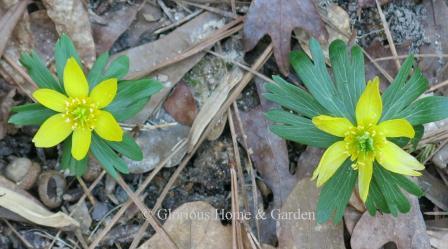 Eranthis hiemalis
Eranthis hiemalisGalanthus elwesii, giant snowdrop, Zones 3-8. G. elwesii is larger in all parts than G. nivalis. It is taller to about 5-9”, the leaves are broader, and the flowers are larger with the outer petals being about 3 times as long as the inner ones. Pure white with green markings on the inner petals.
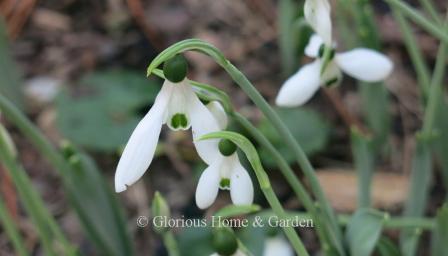 Galanthus elwesii
Galanthus elwesiiGalanthus nivalis, snowdrops, Zones 3-7. A true harbinger of spring, snowdrops emerge from the ground in late winter or early spring--sometimes peeking through the snow. The three pure white petals that flare out like little rotors and the inner cup tinged with green are freshness itself. Snowdrops will perform better in colder climates. Plant in drifts under trees where they will be undisturbed and they will multiply into a magnificent display.
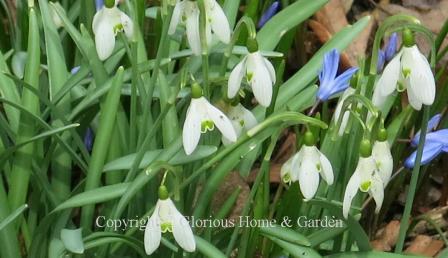 Galanthus nivalis
Galanthus nivalis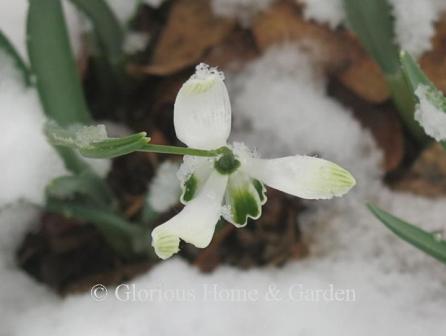 Galanthus nivalis 'Flore-Pleno'
Galanthus nivalis 'Flore-Pleno'Iris danfordiae, Zones 5-9. This small bright greenish-yellow iris with brown spots on the falls blooms close to the ground, and provides welcome winter flowers of cheery color at the gloomiest time of the year. Plant a few in drifts in the fall, or tuck a few in pockets on the edges of beds or under trees where they will be undisturbed.
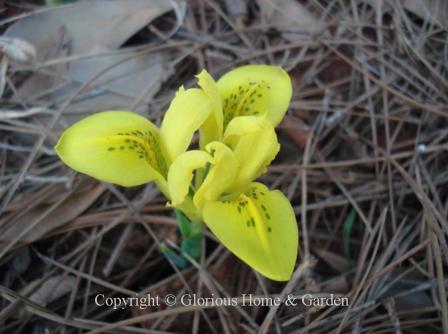 Iris danfordiae
Iris danfordiaeIris ‘Katharine Hodgkin,’ reticulated iris hybrid, Zones 5-8. A lovely little iris this is in pale silvery blue veined with deeper blue and highlighted with yellow splotches.
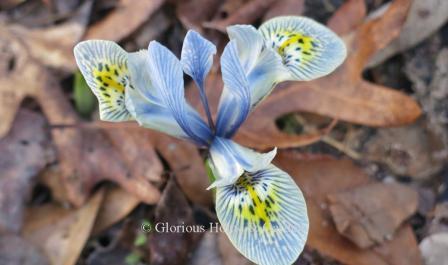 Iris 'Katharine Hodgkin'
Iris 'Katharine Hodgkin'Iris reticulata, reticulated iris, Zones 5-8. A small iris
that blooms in late winter or early spring depending on location and the
weather, the reticulated iris is named for the net-like veining on the
petals. The color range is pale blue to deep violet usually with some
markings of white or yellow. Other cultivars include 'Cantab,' light blue; 'George,' violet; 'Harmony,' dark blue; and 'J. S. Dijt,' reddish-purple.
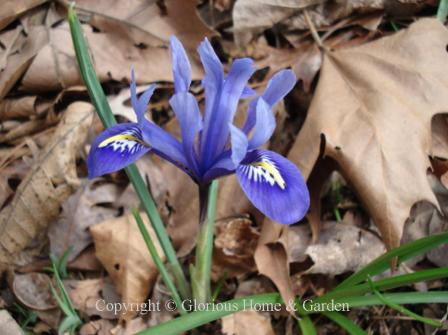 Iris reticulata
Iris reticulata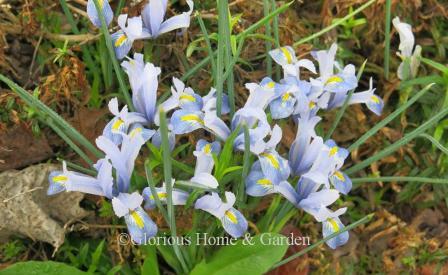 Iris reticulata 'Cantab'
Iris reticulata 'Cantab'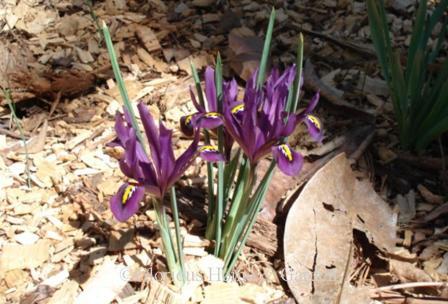 Iris reticulata 'J. S. Dijt'
Iris reticulata 'J. S. Dijt'Iris unguicularis, Algerian iris, Zones 7-9. Known as the winter iris, this North African native blooms in late winter into spring close to the ground as if to protect itself from the winter chill. Best for milder climates similar to its Mediterranean origins.
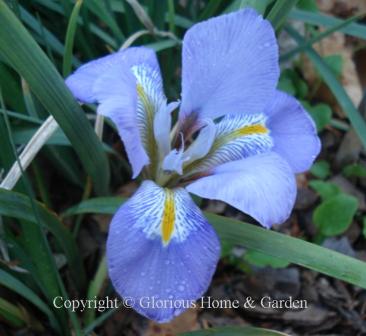 Iris unguicularis
Iris unguicularisLeucojum vernum,
spring snowflake, Zones 4-8. Nodding
white bells with a drop of spring green at their tips, make a charming display
in a woodland setting when planted en
masse.
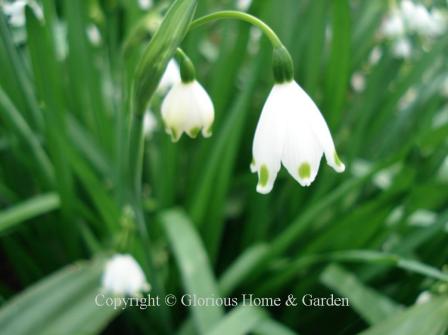 Leucojum vernum
Leucojum vernumPerennials for Winter Flowers
Helleborus foetidus, stinking hellebore, Zones 6-7. Don't let the common name put you off! A bad odor is not readily noticeable, and you can call it bear's foot hellebore, if you prefer. Whatever you call it, this hellebore is a handsome addition to the woodland garden, with narrow dark evergreen leaves and pale, creamy-greenish flowers tinged with a bit of rose around the edges. It will self-seed where happy, preferring moist, humusy, alkaline soils. Be aware that the plant is highly poisonous in all its parts.
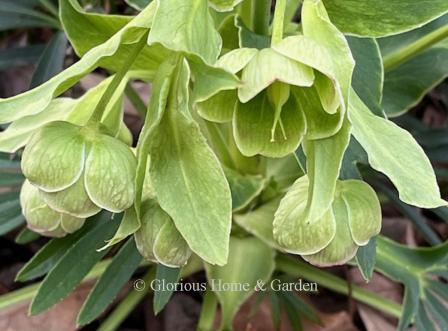 Helleborus foetidus
Helleborus foetidusHellebore Hybrids : hybrid Lenten rose, Zones 4-9. No shady winter garden is complete without Lenten roses. They are tough plants, heat and drought
tolerant, and deer-resistant. Hellebore species and those crosses called H.
x hybridus tend to have down-facing flowers and can self-seed
prolifically—great if you want to develop a large colony —but all you have to
do is cut off the flower stems before the seedpods ripen to prevent this. Recent breeding programs have developed
beautiful hybrids that do not self-seed, and have larger flowers that are more
up-facing. Look for hybrids called Helleborus
x ballardiae, H. x ericsmithii, H. x glandorfensis, and H.
x iburgensis in their nomenclature for cultivars for that are sterile. Some hybrid series to look for include Frostkiss® and HCG® (Helleborus Gold Collection) Ice n' Roses® for sterile varieties.
Hellebores are available in shades of pure white, pink, mauve, plum, purple, and greenish to reds, yellows, apricots, and near black in solids and bicolors, singles and doubles, simple or fancily-frilled. The large, leathery palmate leaves are evergreen and attractive all year, and some of the newer varieties even have beautiful variegated foliage such as Frostkiss® ‘Dorothy’s Dawn™,’ below. Hellebores are easy to care for and are long-lived. Grow them in a shady to semi-shady location, in humus-rich, moist but well-drained soil that is pH neutral. Do not plant in an area that stays wet to prevent rotting. In winter or early spring, when the flower buds and new leaves begin to rise, just cut off the old, tattered leaves from the previous year. For me, in my Zone 7b garden, some varieties begin blooming in late November and continue until April.
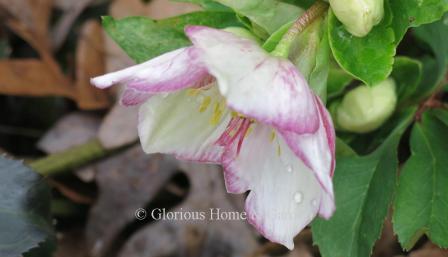 H. x glandorfensis HCG® Ice n’ Roses® ‘Picotee’
H. x glandorfensis HCG® Ice n’ Roses® ‘Picotee’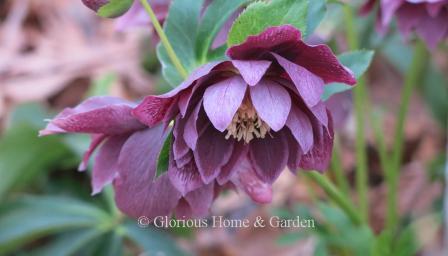 Helleborus x hybridus Winter Jewels® 'Amethyst Gem'
Helleborus x hybridus Winter Jewels® 'Amethyst Gem'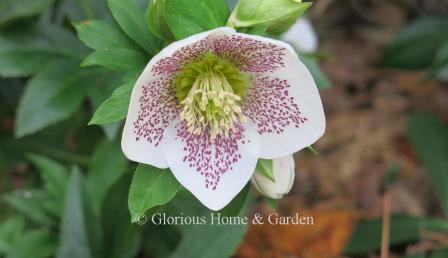 H. x hybridus HGC® Spring Promise® ‘Conny’
H. x hybridus HGC® Spring Promise® ‘Conny’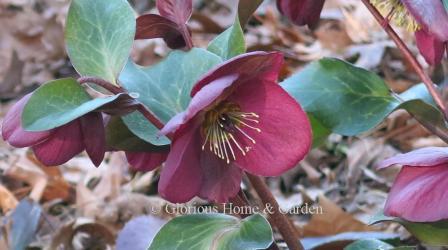 H. x iburgensis Frostkiss® ‘Anna’s Red’™
H. x iburgensis Frostkiss® ‘Anna’s Red’™Helleborus niger, Christmas rose, Zones 3-8. Helleborus niger
is a beautiful plant under the right conditions--it prefers moist,
humusy alkaline soil in a shady location. The pure white flowers with
centers of golden stamens fade to pink as they mature and tend to bloom earlier than the Lenten roses; however, they do not necessarily bloom at Christmastime.
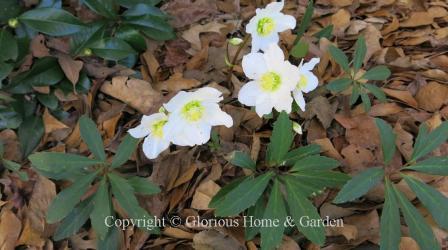 Helleborus niger HCG® ‘Jacob’
Helleborus niger HCG® ‘Jacob’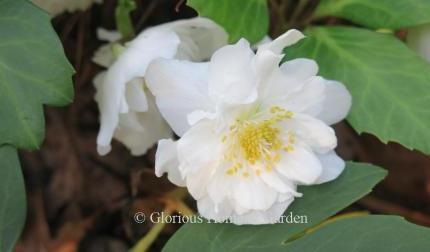 Helleborus niger HCG® 'Snow Frills'
Helleborus niger HCG® 'Snow Frills'Salvia rosmarinus, rosemary, Zones 7-9. The plant we had long known as Rosmarinus officinalis, has apparently been reclassified into the Salvia genus and renamed Salvia rosmarinus. However, it is still the same plant with the same aromatic foliage that is so wonderful for cooking and to brush by in the garden. Flowers appear in the winter in shades of light to dark blue as well as lavender, pink and white.
There are many uses for rosemary. For the winter garden, try combining it in pots with violas or pansies and small late winter/early spring bulbs. Keep a pot near the kitchen door to snip sprigs for cooking. A woody sub-shrub, it takes well to pruning and can be used as a hedge, or even topiary. Rosemary likes full sun, good drainage and is drought tolerant and deer resistant.
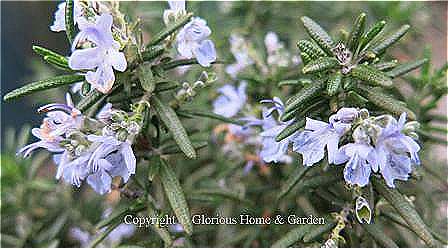 Salvia rosmarinus (or Rosmarinus officinalis)
Salvia rosmarinus (or Rosmarinus officinalis)Click here for shrubs with winter flowers.
Click here for trees with winter flowers.
Plant of the Month
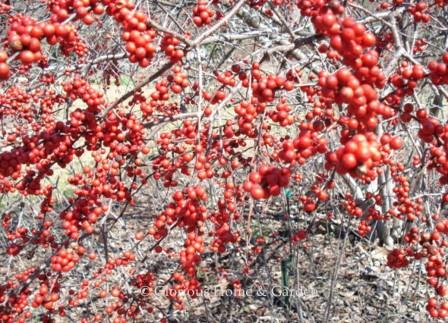
Ilex verticillata
Winterberry holly
Updated new USDA Plant Hardiness Zone Map 2023.